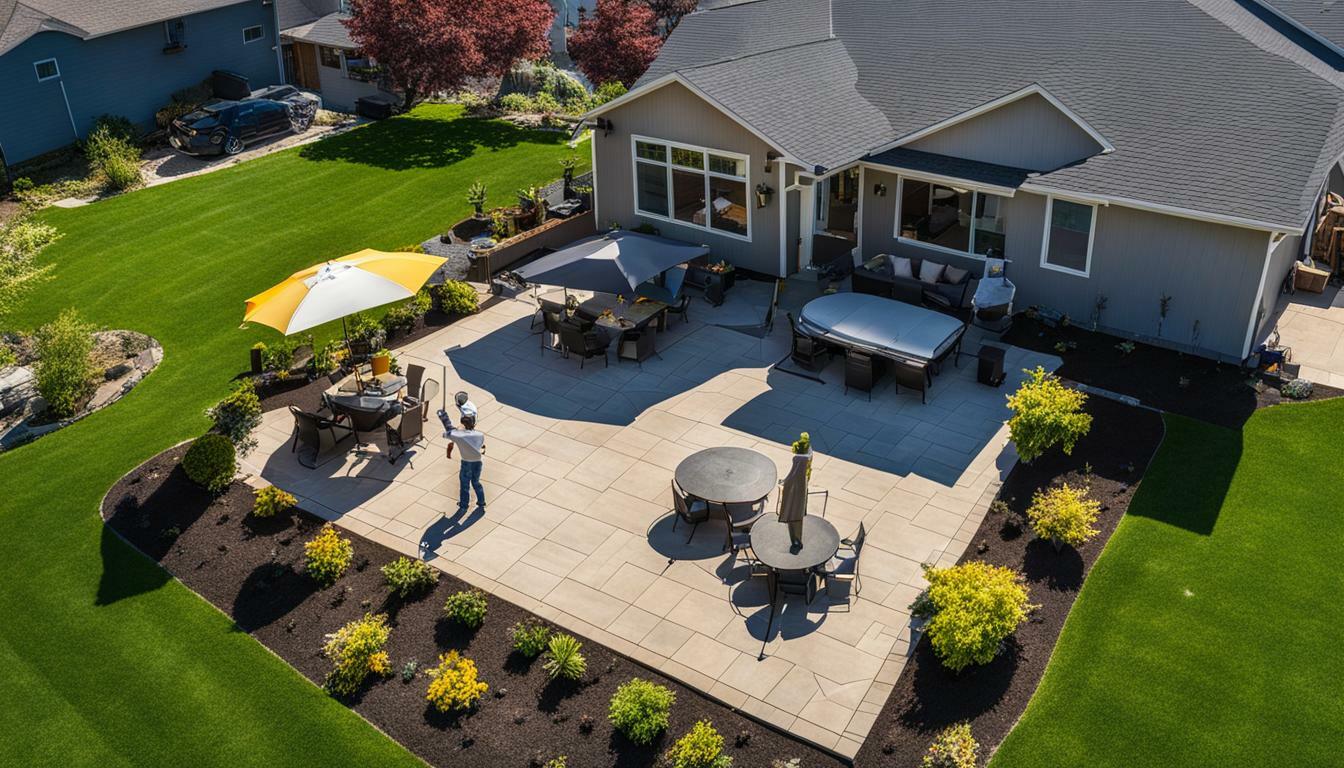Installation Process of Custom Patio Covers: A Step-By-Step Guide

If you’re looking to enhance the outdoor appeal of your home, installing custom patio covers can be a great solution. Not only can they provide shade and protection from the elements, but they can also add a personalized touch to your outdoor space.
While the installation process may seem overwhelming, with the right guidance, it can be a smooth and efficient process. In this section, we will provide you with a step-by-step guide on the installation process of custom patio covers. From planning and design to the finishing touches, you’ll discover everything you need to know to create a customized and functional outdoor space.
Key Takeaways:
- Custom patio covers can enhance the outdoor appeal of your home.
- The installation process can be a smooth and efficient process with the right guidance.
- Planning and design are crucial to creating a customized and functional outdoor space.
- Proper permits and approvals are necessary before beginning the installation process.
- Maintaining your custom patio cover is important for its longevity and functionality.
Understanding Custom Patio Covers
If you’re looking for a way to enhance your outdoor living space, custom patio covers might be just the solution you’re looking for. Custom patio covers are structures designed to provide shade and protection from the elements, while also adding aesthetic appeal to your home.
There are several benefits to choosing custom patio covers over generic solutions. For starters, custom patio covers are tailored to fit your specific outdoor space, ensuring maximum functionality and visual appeal. Additionally, you have the freedom to choose from a variety of materials, styles, and sizes, allowing you to create a unique look that reflects your personal taste.
Types of Custom Patio Covers
There are several types of custom patio covers to choose from, each with its own benefits and drawbacks. Some of the most popular types of custom patio covers include:
| Type | Description |
|---|---|
| Wood Patio Covers | Wood patio covers are a popular option for their natural look and durability. They can be stained or painted to match your home’s exterior. |
| Aluminum Patio Covers | Aluminum patio covers are lightweight, low-maintenance, and resistant to rust and corrosion. They come in a variety of colors and styles. |
| Steel Patio Covers | Steel patio covers are strong and durable, making them a popular choice for areas with harsh weather conditions. They are available in a range of colors and styles. |
| Canvas Patio Covers | Canvas patio covers are versatile and customizable, with a range of colors and patterns to choose from. They are affordable and easy to install. |
Whichever type of custom patio cover you choose, it’s important to consider factors like durability, maintenance, and visual appeal to ensure you make the right choice for your home.
Now that you have a better understanding of what custom patio covers are and the benefits they offer, it’s time to start planning and designing your own. The next section will guide you through the process of choosing the right materials, styles, and sizes for your unique outdoor space.
Planning and Designing Your Custom Patio Cover
Designing your custom patio cover is an essential step in creating an outdoor space that best suits your needs and preferences. The planning process can also help you determine the right materials, styles, and sizes for your unique outdoor area. Follow the steps below to design your custom patio cover.
Assess Your Needs and Preferences
The first step in designing your custom patio cover is to assess your needs and preferences. Think about how you plan to use your outdoor space, whether it’s for entertaining, dining, or simply relaxing. This will help you determine the size and shape of your patio cover, as well as any additional features you may want to include.
Determine the Right Materials
Choosing the right materials for your patio cover is crucial for both functionality and aesthetic appeal. Consider the weather conditions in your area, the overall design of your home, and your budget when selecting materials. Some popular options include wood, aluminum, and vinyl.
Explore Different Styles
Patio covers come in a variety of styles, from classic and traditional to modern and minimalist. Consider the overall design of your home and outdoor space when selecting a style. Some popular options include gable, pergola, and slatted designs.
Create a Design Plan
Once you have assessed your needs, chosen the right materials, and explored different styles, it’s time to create a design plan for your custom patio cover. This should include detailed measurements, a sketch or blueprint of the design, and a list of necessary materials and tools.
Consult with a Professional
If you are unsure about any aspect of your custom patio cover design, consider consulting with a professional. An experienced contractor or designer can help you refine your design plan and ensure that your patio cover is both functional and aesthetically pleasing.
By following these planning and design steps, you can create a custom patio cover that perfectly complements your outdoor space and enhances the overall appeal of your home.
Obtaining Permits and Approvals
Before starting the installation process of your custom patio cover, you need to make sure you have the necessary permits and approvals from local authorities. Failure to obtain the required permissions can result in fines, legal issues, and even the removal of the structure.
The permits and approvals required may vary depending on your location, so it’s important to research the specific regulations in your area. Typically, you will need to obtain permits for any permanent structures that are attached to your home or property. This includes custom patio covers that are installed on a concrete slab or attached to the roof of your home.
To obtain the necessary permits and approvals, you may need to submit building plans and specifications for review by your local building department. The review process can take several weeks, so it’s important to factor this time into your overall installation timeline.
In addition to permits, you may also need to obtain approvals from your Homeowners Association (HOA) or Architectural Review Board (ARB). These organizations typically have their own set of guidelines and regulations that must be followed when making modifications to your property.
To ensure a smooth and hassle-free installation process, it’s important to obtain all necessary permits and approvals before starting any work on your custom patio cover. This will not only help you avoid potential legal issues, but it will also give you peace of mind knowing that your patio cover is compliant with all local regulations.
Preparing the Installation Area
Before starting the installation process, you need to prepare the area where you will install your custom patio cover. This will ensure a stable foundation and a smooth installation. Follow the steps below to prepare your installation area:
- Clear the area: Remove any plants, rocks, or debris from the area where you plan to install your custom patio cover. This will help prevent any damage to the structure.
- Level the ground: Use a shovel and a level to ensure that the ground is level where you plan to install your custom patio cover. This will prevent any water accumulation on the surface.
- Mark the area: Use stakes and string to mark the area where you want to install your custom patio cover. This will help you visualize the final product and ensure that you have enough space for the structure.
By properly preparing your installation area, you will ensure a stable and durable custom patio cover. This will also help prevent any potential damage to your property.
Assembling the Custom Patio Cover Kit
Now that you have all the necessary materials, it’s time to assemble your custom patio cover kit. Following the manufacturer’s instructions, start with assembling the support structure. This includes the posts, beams, and rafters that will hold the cover panels in place.
Ensure that you have all the necessary tools, including a drill, screws, and brackets. It’s also helpful to have a second set of hands to assist with holding the pieces in place while assembling.
Assemble one side of the support structure at a time, starting with the posts and attaching the cross beams and rafters. Make sure all pieces are level and properly aligned before securing them in place with screws and brackets.
Once the support structure is complete, it’s time to attach the cover panels. Lay out the panels and carefully measure and mark where they will need to be cut to fit the support structure. Use a saw to cut the panels to the appropriate size, ensuring a precise fit.
With the panels cut and ready to be attached, use a drill and screws to secure them in place on top of the support structure. Be sure to follow the manufacturer’s instructions for proper spacing and alignment.
Finally, add any finishing touches, such as trim or decorative elements, to complete the look of your custom patio cover.
Installing Support Structure for Your Custom Patio Cover
Installing the support structure for your custom patio cover is an essential part of the installation process. The support structure ensures that the patio cover is stable and can withstand various weather conditions. Here are the steps to follow for a successful installation:
- Determine the post location: Decide where you want to place the posts. Typically, patio cover posts are installed in concrete footings, so ensure that the area is clear of any obstacles before digging.
- Dig the footings: Dig the holes for the footings according to the manufacturer’s instructions. Ensure that the holes are deep enough and wide enough to accommodate the post and the concrete.
- Install the posts: Place the posts in the holes and fill them with concrete. Ensure that the posts are level and plumb. Allow the concrete to dry completely before moving on to the next step.
- Install the beams: Once the posts are securely in place, install the beams. The beams should be level and attached securely to the posts. Depending on the design of your custom patio cover, you may need to use joist hangers to attach the beams.
- Add the rafters: The rafters are the diagonal pieces that attach to the beams and run parallel to the house. Ensure that the rafters are spaced evenly and attached securely to the beams.
- Install any additional support: Depending on the design of your custom patio cover, you may need to install additional support, such as cross beams or braces, to ensure that the structure is stable and secure.
Following these steps will ensure that your custom patio cover has a sturdy and reliable support structure. With the support structure in place, you can move on to the next phase of the installation process.
Attaching the Patio Cover Panels
With the support structure in place, it’s time to attach the panels to your custom patio cover.
Note: Before starting, make sure you have all the necessary tools and materials, including the panels, screws, and drill.
Follow these steps:
- Begin by placing the first panel in the desired position, making sure it is aligned with the support beams.
- Using the drill, secure the panel to the support beams with screws. The number of screws required will depend on the size and weight of the panel.
- Repeat this process with the remaining panels, ensuring there is a small gap between each panel to allow for expansion and contraction.
- Double-check that all panels are securely attached and level.
Tip: To improve the visual appeal of your custom patio cover, consider painting or staining the panels to match the overall style of your home’s exterior.
Overall, attaching the patio cover panels is a straightforward process that requires attention to detail and proper alignment. By following these steps, you can create a beautiful and functional custom patio cover that enhances the outdoor appeal of your home.
Adding Finishing Touches to Your Custom Patio Cover
Once you’ve finished assembling and installing your custom patio cover, it’s time to add the finishing touches to enhance its overall appearance and functionality. Here are some tips to consider:
Painting and Sealing
One of the most common finishing touches for custom patio covers is painting or sealing the materials used. This not only improves the aesthetic value of your patio cover but also protects it from weather damage and general wear and tear. Consider using stains or sealers that are specifically formulated for outdoor use to ensure longevity.
Decorative Elements
Adding decorative elements to your custom patio cover can greatly enhance its overall appeal. Consider adding vines or hanging plants to the structure to create a natural and inviting ambiance. You can also incorporate lighting fixtures or curtains to create a cozy and intimate setting for outdoor gatherings.
Accessories
In addition to decorative elements, you can also add functional accessories to your custom patio cover. For example, consider installing outdoor ceiling fans to help keep the area cool during hot summer days, or add a retractable awning for additional sun protection. Furniture and other outdoor decor can also help to create a comfortable and inviting outdoor space.
Regular Maintenance
After completing the installation and adding the finishing touches, it’s important to perform regular maintenance on your custom patio cover to ensure its longevity and functionality. This includes regular cleaning and inspection of the materials and hardware, as well as making any necessary repairs or replacements.
By following these tips for adding the finishing touches to your custom patio cover, you can create a functional and stylish outdoor space that enhances the overall value and appeal of your home.
Ensuring Proper Drainage for Your Custom Patio Cover
When it comes to installing a custom patio cover, proper drainage is key to ensuring its longevity and functionality. Without it, water can accumulate and potentially cause damage to both your patio cover and your home. Here are some important steps to take to ensure proper drainage:
- Slope: The slope of your patio cover should be at least 1/4 inch per foot. This will ensure that water flows away from your home and does not accumulate on top of your patio cover.
- Gutter Systems: Installing gutter systems can help to direct water away from your patio cover and your home’s foundation. These should be installed along the perimeter of your patio cover and connected to downspouts that lead to a safe drainage area.
- Sealing: Make sure that all joints and seams of your custom patio cover are properly sealed to prevent water from seeping through and causing damage over time.
By following these steps, you can ensure that your custom patio cover is not only visually appealing but also functional and durable. Proper drainage will also help to prevent any potential issues and allow you to fully enjoy your outdoor space for years to come.
Maintaining Your Custom Patio Cover
After installing your custom patio cover, it’s important to maintain it to ensure its longevity and functionality. The following tips will help you keep your patio cover in good condition for years to come.
Cleaning
Regular cleaning is crucial for maintaining the appearance of your patio cover. Use a soft-bristled brush or cloth and a mild detergent to remove dirt and debris from the cover. Rinse thoroughly with a garden hose and allow it to air dry.
For metal patio covers, avoid using abrasive cleaners that can scratch the surface. Instead, use a solution of water and mild dish soap to remove dirt and grime.
Inspection
Perform regular inspections of your patio cover to check for any signs of damage or wear. Look for cracks, rust, or discoloration that may indicate a need for repairs. Check the hardware and connections to ensure they are secure and functioning properly.
Repairs and Replacements
If you notice any damage or wear during your inspections, it’s important to address it promptly. Repair any cracks or damage to the cover using a patch kit or sealant, depending on the material. Replace any rusted or damaged hardware or connections to ensure the stability of the cover.
Protective Measures
Consider adding protective measures to your patio cover to increase its durability and longevity. Apply a sealant or paint to wooden covers to protect against moisture and sun damage. Install gutter systems to prevent water accumulation and potential damage to the cover and surrounding area.
By following these maintenance tips, you can ensure your custom patio cover remains a functional and attractive addition to your outdoor space for years to come.
Conclusion
In conclusion, installing custom patio covers can significantly enhance the outdoor appeal of your home. By following the step-by-step guide provided in this article, you can create a functional and customized outdoor space that suits your unique needs and preferences.
Remember to carefully plan and design your custom patio cover, obtain the necessary permits and approvals, and prepare the installation area properly. Assemble your custom patio cover kit and install the support structure, ensuring proper spacing and alignment.
Take care when attaching the panels and adding finishing touches, such as painting and sealing, to enhance the visual appeal and durability of your custom patio cover. Finally, ensure proper drainage and maintenance to extend the life and functionality of your patio cover.
By investing in the installation process of custom patio covers, you can create a beautiful and functional outdoor space for you to enjoy for years to come.
FAQ
What is the installation process for custom patio covers?
The installation process for custom patio covers involves several steps, including preparing the installation area, assembling the custom patio cover kit, installing the support structure, attaching the patio cover panels, and adding finishing touches. Each step requires careful planning and attention to detail to ensure a successful installation.
What are custom patio covers?
Custom patio covers are specifically designed and tailored to fit your unique outdoor space. They provide shade, protection, and aesthetic appeal to your patio or outdoor area. Custom patio covers are made to measure and can be customized in terms of materials, sizes, styles, and colors.
How should I plan and design my custom patio cover?
When planning and designing your custom patio cover, consider factors such as the size of your patio, the desired level of shade and protection, and the overall aesthetic you wish to achieve. Choose materials that are durable and weather-resistant, and select a style that complements your home’s architecture. It’s also important to obtain any necessary permits or approvals before proceeding with the installation.
How do I obtain permits and approvals for a custom patio cover?
Before starting the installation of your custom patio cover, you should check with your local authorities to determine what permits or approvals are required. This typically involves submitting plans or specifications of the project and paying any applicable fees. It’s important to follow the rules and regulations set by your local jurisdiction to ensure a legal and compliant installation.
What should I do to prepare the installation area for a custom patio cover?
Preparing the installation area for a custom patio cover involves clearing the space of any debris or obstacles and ensuring a level surface. This may require removing plants, rocks, or other items that could interfere with the installation. It’s important to create a stable foundation for the patio cover to ensure its longevity and structural integrity.
How do I assemble a custom patio cover kit?
Assembling a custom patio cover kit typically involves following the manufacturer’s instructions provided with the kit. The instructions should outline the necessary steps, including attaching support posts, beams, and rafters, as well as connecting the panels or roofing material. It’s important to carefully follow the instructions to ensure a proper and secure installation.
What is involved in installing the support structure for a custom patio cover?
Installing the support structure for a custom patio cover involves selecting the appropriate materials, such as pressure-treated lumber or metal posts, and ensuring proper spacing and alignment. The support structure provides the necessary stability and strength for the patio cover. This step is crucial to ensure the overall structural integrity of the installation.
How do I attach the panels to a custom patio cover?
Attaching the panels to a custom patio cover can be done using various methods, such as screws, nails, or clips. The specific method will depend on the type of panels and roofing material chosen for your patio cover. It’s important to follow the manufacturer’s instructions and use the recommended fasteners to ensure a secure and visually appealing installation.
What finishing touches can I add to my custom patio cover?
There are several finishing touches you can add to your custom patio cover to enhance its overall look and durability. These include painting or staining the materials to match your home’s exterior, sealing the wood to protect against moisture and UV damage, and incorporating decorative elements such as lighting fixtures or architectural details.
How can I ensure proper drainage for my custom patio cover?
Proper drainage is essential to prevent water accumulation and potential damage to your custom patio cover. Ensure that your patio cover has a slight slope to allow water to run off. Consider installing gutter systems or downspouts to direct water away from the structure. Additionally, you can explore other drainage solutions, such as French drains or permeable pavers, to further enhance drainage capabilities.
What maintenance is required for a custom patio cover?
Regular maintenance is necessary to prolong the lifespan and functionality of your custom patio cover. This includes cleaning the surface, inspecting for any signs of damage or wear, and addressing any necessary repairs or replacements promptly. Depending on the materials used, you may also need to periodically reseal or repaint the patio cover to maintain its appearance and protect against the elements.
- Crafting a Dream Patio with Pavers - November 26, 2023
- DIY Patio Paver Construction - November 24, 2023
- Creating Stunning Patios with Pavers - November 21, 2023


